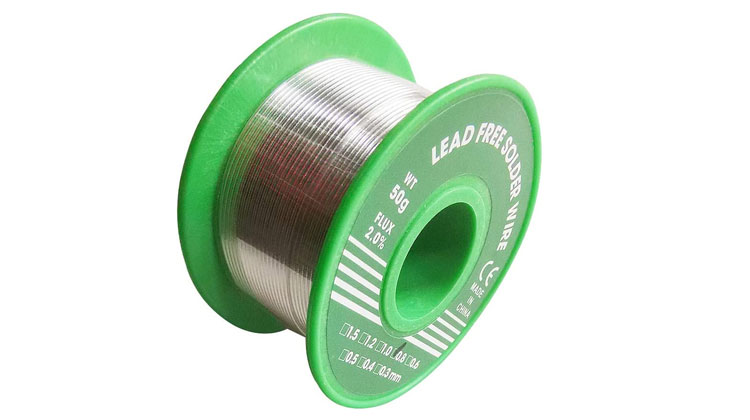The most popular solder is lead-free solder, a type of solder that does not contain lead and is used in various applications, including electronics, plumbing, automotive, and aerospace. Lead-free solder is preferred over leaded solder, which contains lead due to its environmental, health, and safety benefits, as well as its technical and legal requirements.

Lead-free solder is made of a metal or an alloy that does not contain lead, such as tin, copper, or silver, and it has a melting point that is higher than leaded solder, typically between 180 and 400 degrees Celsius, depending on the type of alloy and the application. Lead-free solder is also known as rosin-free solder, as it does not contain rosin, a type of flux used in leaded solder but is harmful to the environment and human health. Lead-free solder is also known as no-clean solder, as it does not require cleaning after the soldering process due to its low residue and high reliability.
Lead-free solder is used in a variety of applications where leaded solder cannot or should not be used due to its environmental, health, and safety concerns. Lead-free solder is used in electronics, where it is used to join electronic components, such as chips, capacitors, resistors, and connectors, and to create printed circuit boards, or PCBs, which are the backbone of electronic devices. Lead-free solder is also used in plumbing, where it is used to join pipes, fittings, and valves and to create water and gas distribution systems, or HVAC systems, which are essential for buildings and infrastructure. Lead-free solder is also used in automotive, where it is used to join parts, such as frames, engines, and transmissions, and to create vehicles, which are essential for transportation and mobility. Lead-free solder is also used in aerospace, where it is used to join parts, such as fuselages, wings, and engines, and to create aircraft, which are essential for defense, exploration, and transportation.
Lead-free solder is preferred over leaded solder due to its environmental, health, and safety benefits, as well as its technical and legal requirements. Lead-free solder is environmentally friendly, as it does not contain lead, a toxic and hazardous metal, and does not release harmful fumes or residues during the soldering process. Lead-free solder is also healthier, as it does not contain lead, which is harmful to human health, and it does not require the use of rosin, which is harmful to the environment and human health. Lead-free solder is also safer, as it does not contain lead, which is flammable and explosive, and it does not require the use of flux, which is corrosive and toxic.
Lead-free solder is also preferred over leaded solder due to its technical and legal requirements, which are imposed by governments, industries, and standards organizations, to protect the environment and human health and to ensure the quality and reliability of products and systems. Lead-free solder is required by technical standards, such as the J-STD-006 and the IPC-J-STD-004, which are the standard specifications for soldering materials and processes, and that are used by the electronics and aerospace industries, respectively. Lead-free solder is also required by legal regulations, such as the RoHS and the REACH, which are the European directives for the restriction of hazardous substances and the registration, evaluation, authorization, and restriction of chemicals, respectively. Lead-free solder is also required by environmental labels, such as the ecolabel and the energy star, which are the European and the American labels for environmental performance and energy efficiency, respectively.
Lead-free solder is also preferred over leaded solder due to its technical advantages, which are related to its melting point, flow, wetting, bonding, and reliability. Lead-free solder has a higher melting point than leaded solder, which allows it to withstand higher temperatures and stresses and avoid melting or flowing during the soldering process. Lead-free solder has a better flow than leaded solder, which allows it to fill gaps and voids and to avoid cold or hot joints during the soldering process. Lead-free solder has better wetting than leaded solder, which allows it to spread evenly and uniformly over the metal surfaces and to avoid voids or excess during the soldering process. Lead-free solder has a better bonding than leaded solder, which allows it to create a strong and durable joint and to avoid fractures or failures during the soldering process. Lead-free solder has better reliability than leaded solder, which allows it to maintain its performance and integrity over time and avoid corrosion or failure during the soldering process.
In conclusion, the most popular solder is lead-free solder, a type of solder that does not contain lead and is used in various applications, including electronics, plumbing, automotive, and aerospace. Lead-free solder is preferred over leaded solder due to its environmental, health, and safety benefits, as well as its technical and legal requirements and its technical advantages. By using lead-free solder, the solderer can create a strong, durable, and reliable soldered joint and contribute to the protection of the environment and human health.
Contact: Mr. Li
Phone: (0086) 138 24254 321
E-mail: atetool@atetool.com.cn
Add: 5F, 1-2# Building, Tongfuyu Industrial Zone, Aiqun Rd, Shiyan Subdistrict, Bao'an, Shenzhen, 518108, China